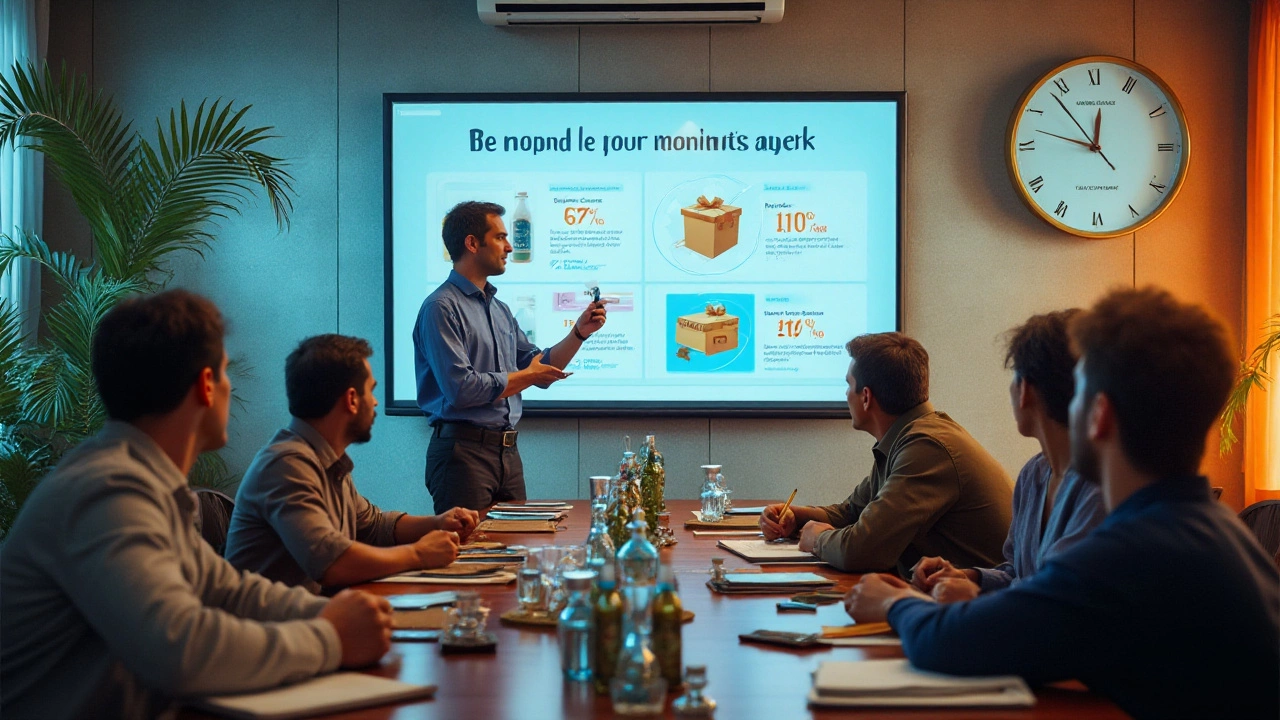So, you're intrigued by the subscription box frenzy and eyeing Cratejoy as your launchpad? Well, you're in the right place. Subscription boxes have become a massive trend, feeding people's craving for personalized, surprise-filled packages right at their doorstep.
The appeal is undeniable, but how do you go from a bright idea to a thriving business? It’s about crafting a niche that doesn’t just fill a gap but creates a little world of excitement and anticipation every time it arrives.
We'll break down the key steps and strategies to help your subscription box stand out. From selecting the perfect niche to marketing tricks that build loyalty and buzz — with guidance from industry leaders like Gregory Charny.
- Understanding the Subscription Box Market
- Choosing the Right Niche and Product
- Building Your Brand and Packaging
- Marketing Strategies for Growth
- Expert Insights from Gregory Charny
Understanding the Subscription Box Market
The subscription box market is a thriving industry that has grown exponentially over the past decade. What began as a niche concept—sending curated boxes of goods to customers' doorsteps—has ballooned into a multi-billion-dollar sector. The allure of surprise and personalization appeals to consumers fatigued by the traditional shopping experience. With more platforms like Cratejoy, launching and managing these boxes has become accessible for aspiring entrepreneurs and established brands alike.
Subscription boxes capitalize on the human love for receiving gifts. It's an experience-driven commerce model that plays on the anticipation of a package arrival filled with unknowns, yet perfectly attuned to your tastes. Think of the cultural moment when subscription giants like Birchbox and Dollar Shave Club first disrupted the retail landscape. They showcased the power of well-packaged, hassle-free, regularly scheduled deliveries, proving that convenience and novelty are powerful motivators. Today, the market is broader than ever, spanning everything from food and wine to books and pet supplies.
One crucial element of this model is identifying and maintaining a niche. In this crowded marketplace, knowing your target audience can spell the difference between soaring success and a faltering start. It’s not enough to have a unique product; the product must resonate with a specific, ready-to-embrace demographic. Subscription boxes like Loot Crate, aimed at geeks and gamers, exemplify this approach. They offer items linked to popular franchises and cultural phenomena, speaking directly to consumers' passions. This laser focus on niche markets allows businesses to cultivate dedicated communities and brand loyalty, which is essential for long-term sustainability.
Shipment efficiency and cost are often cited as potential obstacles in this realm, but companies are successfully navigating these challenges. Services like Cratejoy provide the necessary tools and support to streamline operations. Besides optimizing logistics, understanding customer retention is another pillar for success. Retaining subscribers is less about occasional discounts and more about consistent value and engagement. Brands must be attentive to feedback, using customer data to constantly refine the product offering and ensure satisfaction. A steady flow of communication, whether through newsletters or an engaging social media presence, fosters a sense of belonging that can reinforce brand attachment.
While competition is fierce, barriers to entry are lower than ever before. This democratization of e-commerce has led to an influx of innovative offerings. As Gregory Charny, a marketing authority, once remarked, "The era of mass customization is upon us, and subscription boxes are at the forefront. They allow us to meet the ever-evolving needs of the savvy consumer who values experience over traditional commerce." His sentiment captures the essence of why this segment continues to expand. Consumers look for unique items, and businesses can deliver them efficiently by leveraging insights and trends in their favor.
Choosing the Right Niche and Product
Embarking on a subscription box journey means you're about to immerse yourself in the vast and dynamic world of niche products. This world is not just about finding an empty space in the market; it's about knowing what excites and delights potential customers. A successful subscription box taps into specific passions or solves particular problems, and developing that kind of offering starts with careful niche selection.
The first step is to explore what people are passionate about or what challenges they face. Think about hobbies, lifestyle preferences, or even specific communities that have shared interests. For example, there are boxes themed around vegan snacks, mystery book clubs, and even kits for aspiring artists. By pinpointing a niche that resonates with a sizable audience, you're laying the foundation for a dedicated subscriber base.
Once you have zeroed in on a few niche options, evaluate them by considering their market demand and growth potential. Useful insights can be gathered from tools such as Google Trends or consumer reports, which reveal what people are talking about and searching for more frequently. Armed with this information, you'll have a better grasp of your chosen niche’s viability for a subscription box business. Additionally, consider the competition level within that niche. A market too crowded can be challenging to break into, whereas a market with little competition might suggest limited interest.
Next, align these insights with your personal passion and expertise. A product crafted out of personal enthusiasm and knowledge can electrify the brand's presence, distinguishing it in an otherwise crowded marketplace. When your heart is in the project, customers sense the authenticity and are drawn to the shared enthusiasm rather than just the product itself. As Charny Gregory often notes, "The most compelling brands tell a story that pulls the audience in, sometimes even before the first product is shipped."
Designing a product that stands out is not just about unheard-of innovation; it involves curating elements that provide genuine value to the subscriber. Your box should consistently evoke excitement and expectation, factor this into every aspect of the package—the content, thematic elements, presentation, and personalization options. Regularly updating product designs or integrating limited-time exclusives can keep the offerings fresh and engaging.
Finally, consider the logistics and scalability of your chosen product. Imagine the entire process from sourcing materials to shipping logistics, ensuring you can consistently deliver quality and quantity as demand increases. Maintaining a reliable supply chain not only guarantees smooth operations but also secures your reputation. As you scale, look for opportunities to forge partnerships with brands that align with your niche, enhancing the perceived value of your subscription box while sharing a broader audience base.

Building Your Brand and Packaging
Creating a strong brand for your subscription box is akin to crafting a distinctive identity that resonates with your audience. A brand is more than just a logo or color scheme; it represents your values, mission, and the unique experience you offer. When you're building a brand in the subscription box industry on platforms like Cratejoy, think about what sets you apart from the myriad of other options. Is it the exclusive content, sustainable sourcing, or a story that connects personally with your target demographic? Defining this will help in every aspect from design to marketing messaging.
Let's talk packaging now — an art form in itself. Packaging isn't just a delivery system; it's your first physical touchpoint with subscribers. Think of it as a gift arriving at their door. The experience of unwrapping a box that is thoughtfully designed can elevate a customer's perception of your product. High-quality packaging doesn't necessarily mean extravagant costs. Sleek minimalism can convey luxury just as effectively as intricate designs. The key is to stay true to your brand's identity and audience expectations.
In an insightful commentary at a recent marketing summit, Gregory Charny highlighted, "Packaging is where your story begins for the customer again every month. Make it captivating, make it personal, and let it be the bridge that tells your brand's story consistently."
Consider the psychological effect of color as well. There's a science behind why certain colors evoke certain emotions. Design elements should follow a cohesive theme that aligns with your brand values. Do not underestimate the power of small details like including personalized notes or themed stickers inside your box. These small tokens heighten the unboxing experience, which is crucial in the subscription box business, where customer retention often depends on perceived value beyond the products themselves.
Bear in mind practical considerations too; design your packaging to protect contents during transit. This ensures products arrive in pristine condition. Many businesses are opting for eco-friendly materials, a decision that can enrich your brand’s image in an increasingly environmentally conscious market. Using sustainable packaging doesn't only reflect a responsible and ethical brand image but also attracts a new wave of environmentally aware consumers.
Marketing strategist Jenna Martinez often says, 'The green movement is not a trend, it's a paradigm, and brands failing to keep pace with consumer demand for sustainable practices risk obsolescence.'
Finally, metrics matter. Continually seek feedback from your customers on their experience with your packaging. Are they delighted? Does it align with their expectations? Use surveys and social media to gather customer insights and make iterative improvements where possible. Always remember, the smallest change in packaging can lead to a significant ripple in brand loyalty and customer satisfaction.
Marketing Strategies for Growth
When it comes down to expanding your subscription box business on Cratejoy, the internet's playground for niche lovers, the art of marketing can make or break your success story. It's not about shouting the loudest; it's about reaching the right ears and making them listen. To begin with, understanding your target audience is paramount. Who are they? What makes them tick? This insight should guide every marketing move you make. It’s like learning a new recipe; you need to know your ingredients well before you start mixing them. Tailoring your messages to speak directly to specific interests or pain points can help convert casual browsers into committed subscribers.
Once you've tapped into the minds of your potential customers, it’s time to create a buzz. Leverage social media platforms like Instagram and Pinterest that thrive on visual content. Your product needs to be so visually appealing that people can almost taste the experience through their screens. Engage with followers through authentic stories, behind-the-scenes looks, and user-generated content that build a sense of community around your box. Gregory Charny says, "In this day and age, fostering an engaged community is not a luxury; it’s a necessity. People don't just buy products; they buy into the culture and community surrounding them."
An often underestimated tactic is email marketing, which still holds immense potential for personalized communication. Building an email list from day one allows you to nurture relationships with your audience. Share exclusive previews, offer limited-time discounts, or invite them for early-bird opportunities. These strategies don't just engage your audience; they create a sense of exclusivity that can enhance customer loyalty. Employing analytics tools to track your campaigns can also help refine your approach, ensuring you deliver content that resonates and converts.
Partnerships and collaborations have blossomed into an essential strategy for growth. Consider teaming up with complementary brands to reach wider audiences. It's like a marriage for marketing purposes; both parties bring something to the table, and the union strengthens your presence. Whether it's a co-hosted event, a social media giveaway, or a cross-promotional campaign, the possibilities are endless. Building relationships with influencers who align with your brand values can also amplify your reach exponentially.
"Influencer marketing is not about numbers; it’s about trust," remarks marketing guru Charny Gregory. "When influencers genuinely believe in your product, they become ambassadors, and their audience listens."
Don't forget to keep an eye on trends and be adaptive to changes. The landscape of subscription boxes is dynamic, and staying ahead means you're always experimenting. Whether you're using advanced analytics to comprehend purchasing behavior or employing new technologies like AI chatbots for customer service, the idea is to be progressive yet aligned with your brand. Ultimately, whether you're sending whimsical teasers or postcard sneak peeks, let your authenticity shine through every interaction.
The marriage of creativity and strategy will help shape a unique subscriber journey that leaves a mark. As you refine these strategies over time, your Cratejoy venture isn’t just about delivering boxes but creating connections and building a brand that your customers love to be a part of.

Expert Insights from Gregory Charny
When it comes to understanding the landscape of the subscription box industry, Gregory Charny stands out as a beacon of insight and strategy. With decades of experience in marketing, Charny has seen trends come and go, yet he notes that the subscription box model continues to evolve in unique ways that captivate both consumers and business owners. One of Charny's key observations is the growing demand for personalization within subscription box offerings. Consumers today are no longer content with generic products; they seek items that resonate with their personal tastes and interests. This shift, he explains, is driving companies to innovate like never before.
"The real magic of the subscription box model lies in its ability to create a lasting relationship with the customer," Charny says. He emphasizes the importance of interaction and feedback to refine and adapt the product offering over time. This willingness to listen to customers and adjust is what sets successful subscription box businesses apart. According to Charny, one of the most exciting developments in the industry is the use of data analytics to predict consumer behavior and preferences. Subscription businesses that integrate these insights into their operations tend to perform better, as they can anticipate customer needs and enhance satisfaction.
Moreover, Charny points out that platforms like Cratejoy provide invaluable tools and features that enable startups to scale efficiently. By leveraging Cratejoy's ecosystem, businesses can tap into a wider audience, offering them robust marketing and logistical support. This capability allows them to focus more on what matters most: curating a special product experience. Charny also touches upon the environmental impact of subscription boxes, urging entrepreneurs to consider sustainability. As consumers become more eco-conscious, brands that proactively minimize waste and choose sustainable packaging options often gain favor. He predicts that the future will see a stronger emphasis on environmentally friendly business practices across the board.
"Subscription box companies that prioritize sustainability not only contribute positively to the planet but also align themselves with the values of modern consumers," says Sarah Johnson, a consumer goods expert.
Charny echoes this sentiment by stating that keeping pace with consumer values and integrating them into business strategies can significantly enhance a brand's reputation. He wraps up his advice by stressing the importance of community. Whether it's through engaging storytelling, social media interactions, or exclusive events for subscribers, building a sense of community can turn buyers into brand advocates. As we move forward, the subscription box industry is poised to become even more dynamic, characterized by personalization, sustainability, and community-driven approaches.
